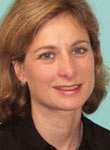Bethe lecturer: We may be close to knowing if there are more dimensions
By Vivek Venkataraman

By looking out across the cosmos and down to subatomic distances, scientists may soon be able to uncover the mechanism that gives particles mass and verify whether extra dimensions of space -- beyond the usual three -- exist, according to Lisa Randall, the spring 2012 Bethe lecturer.
"Science is about refining our knowledge as we probe deeper and deeper inside matter and out into the universe ... what matters is the scale or resolution at which you are looking at things," said Randall, the Frank B. Baird Jr. Professor of Science at Harvard University, May 1 in Schwartz Auditorium, Rockefeller Hall.
The laws of classical physics, albeit an approximation, are sufficiently accurate to describe phenomena at human scales, she said. However, things look very different at atomic scales, where quantum mechanical laws are required to describe reality.
The frontier of experimental physics today lies in probing the nature of reality at scales less than a millionth of a trillionth of a meter, she said, specifically at the Large Hadron Collider (LHC) in Geneva, Switzerland, where protons traveling at nearly the speed of light collide with each other.
Scientists working with the LHC hope to answer such fundamental questions as Why do particles acquire mass? Why is gravity so weak compared to other forces like electromagnetism? and What is the origin of dark matter in the universe?
"The only way we know of [theoretically] for particles to acquire masses is the Higgs mechanism ... particles interact with a 'charge' spread throughout empty space. Heavier particles interact more, and lighter particles interact less. The LHC has seen hints of the Higgs, and we'll know by the end of the year whether it's real or not," said Randall.
Cosmological observations suggest that about 83 percent of the matter in the universe is invisible: It neither emits nor scatters light, but its gravitational effect on ordinary visible matter is evident. Such "dark matter" might be made up of unknown fundamental particles that might be created in high-energy proton collisions at the LHC, Randall said.
Theoretical physicists can imagine length scales much smaller than the limit of experimental capabilities today. String theory posits that at the core of matter the fundamental objects are not particles but tiny [a trillionth of a trillionth of a trillionth of a meter] vibrating strings. This might be the smallest distance scale in the universe, and it might not be possible to see smaller distances even in principle, said Randall.
She explained that the weakness of gravity compared with other forces like electromagnetism might be explained by the existence of extra dimensions of space beyond the usual three of up-down, forward-backward and left-right. Gravity may act over all the spatial dimensions, while the other forces are restricted to our world of three. The LHC might produce particles that travel in these extra dimensions if this idea is correct, she said.
The Bethe Lectures honor Hans A. Bethe, Cornell professor of physics from 1936 until his death in 2005. Bethe won the Nobel Prize in physics in 1967 for his description of nuclear processes that power the sun.
Graduate student Vivek Venkataraman is a writer intern for the Cornell Chronicle.
Media Contact
Get Cornell news delivered right to your inbox.
Subscribe